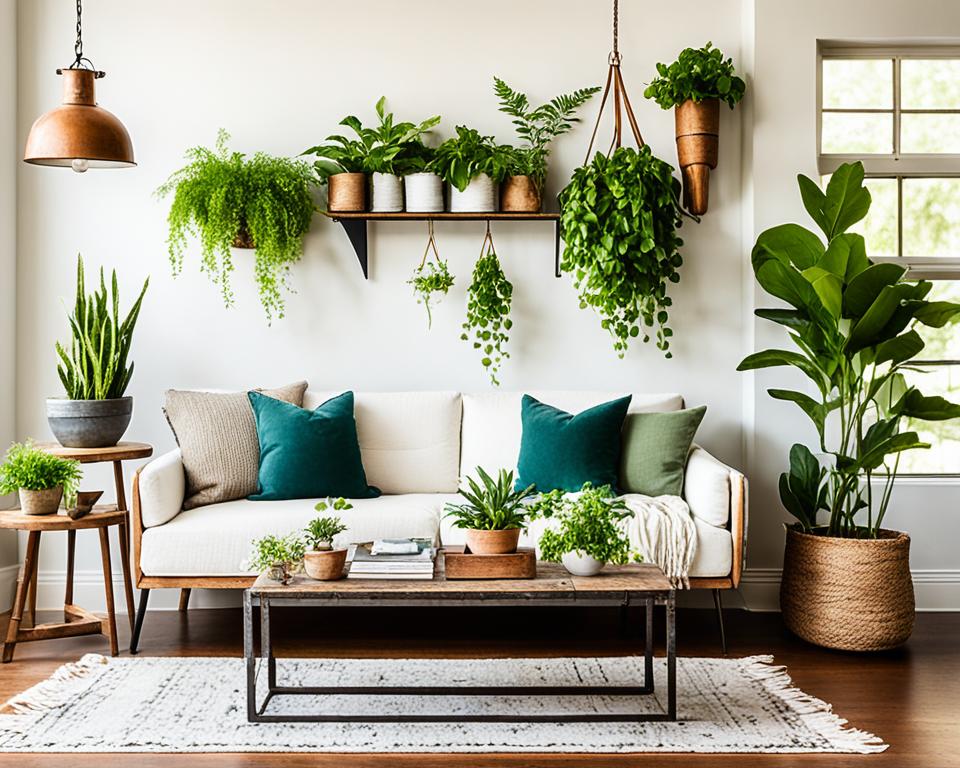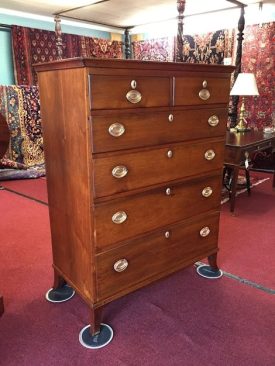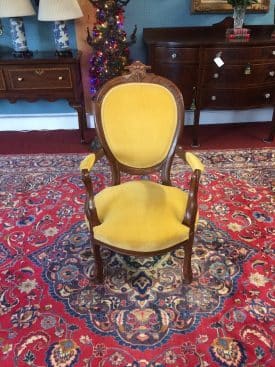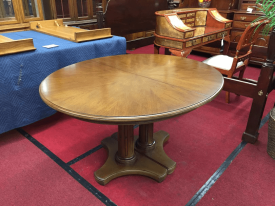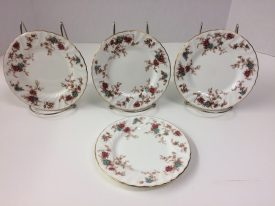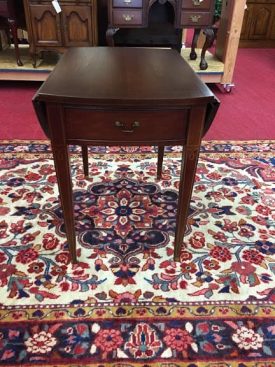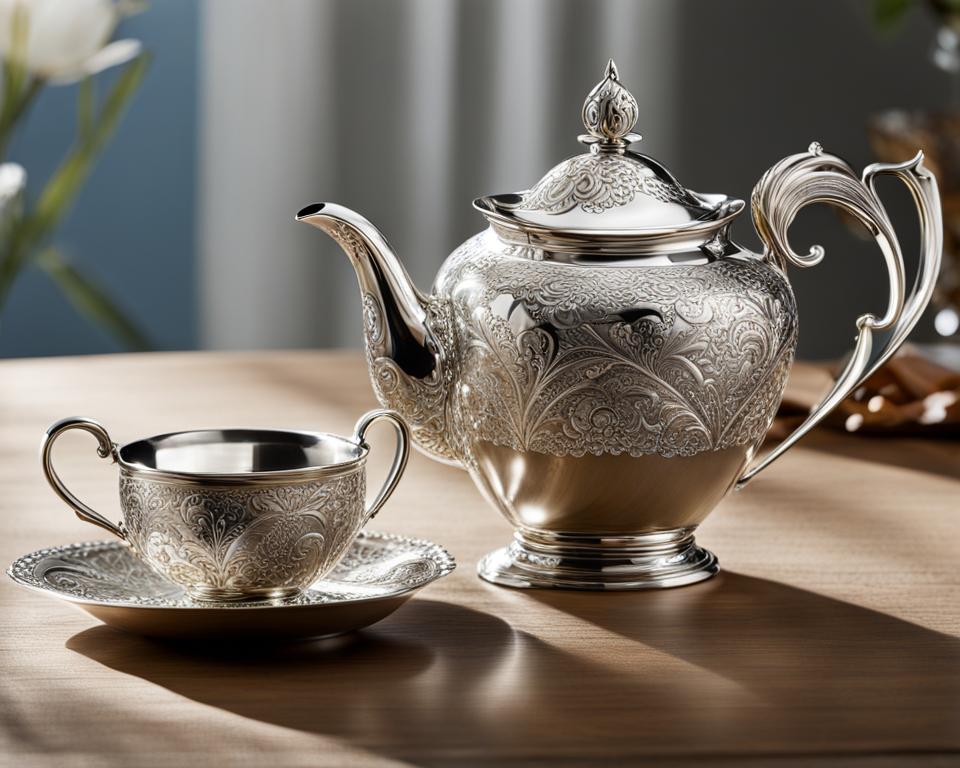As awareness of our ecological footprint grows, so does our pursuit for green living spaces. The art of eco-friendly home decorating is not just about enhancing aesthetics—it’s a mindful approach that coalesces style with sustainability. With a plethora of sustainable decor ideas, homeowners are now empowered to make choices that benefit their environment as much as their wellbeing. This is the essence of green home design: a seamless blend of natural elements, energy-conscious solutions, and timeless pieces that together create harmonious, responsible, and breathtaking living spaces.
Understanding that decor is more than mere ornamentation, eco-friendly home decor stands as a testament to the belief that beauty and environmental stewardship can walk hand in hand. In this way, we can curate our homes to be sanctuaries that not only soothe the soul but also foster the health of the planet. Reflecting an innate respect for our natural world, sustainable home design is an enlightening journey towards a resilient, joyous and greener tomorrow.
Key Takeaways
- Eco-friendly home decorating combines beauty with sustainability for a minimal environmental footprint.
- Sustainable decor principles prioritize the use of natural and energy-efficient materials in home design.
- Green living spaces support the health of individuals and the planet by reducing exposure to toxic chemicals.
- Quality over quantity is fundamental in green home design, including the adoption of durable, timeless furnishings.
- Creating an eco-conscious living space means recognizing that each design choice impacts our global ecosystems.
- Green home decor goes beyond aesthetics, enhancing the wellbeing of occupants and contributing to a sustainable future.
Why Embrace Eco-friendly Home Decorating?
In an age where eco-conscious living becomes increasingly pivotal, it is essential to understand the abundance of benefits tied to environmentally friendly home decor. By incorporating elements that prioritize a sustainable lifestyle, not only do individuals contribute to the preservation of our beautiful planet, but they also invite a multitude of wellness benefits into their sanctuaries.
Health Benefits and Environmental Impact
Embracing a lifestyle of eco-friendly home decorating comes with a treasure trove of health advantages, stemming from a mindful selection of materials that enhance indoor air quality and foster well-being. The use of low-VOC paints and sustainably sourced furnishings significantly diminish the presence of airborne pollutants, making our homes safer and more nurturing.
Principles of Sustainable Living: Environmental, Economic and Social Considerations
Sustainable decor resonates deeply with the principles of a balanced, enjoyable existence on this planet. Resources that are compassionate to the environment, such as renewable materials, ethically sourced commodities, and low carbon footprint products, stand at the core of sustainable lifestyle choices. These choices reflect an enlightened understanding that every home decoration choice casts a ripple across our global ecosystem.
The Philosophy of Sustainable Decor Ideas
At the heart of modern home aesthetics lies a movement profoundly rooted in the philosophy of sustainability—eco-friendly interior styling. It’s a transformative approach that harmonizes human comfort with global environmental preservation, facilitated by an array of sustainable home accessories and green home decor. This new paradigm in design transcends traditional limitations, allowing for a breadth of artistic expression that honors both ecological consciousness and individual style.
Much more than an adherence to a color palette or specific design scheme, this philosophy nurtures a connection with the natural world from within our living spaces. Accentuating the deep-seated human need for environmental consonance, it guides the choice of materials, production methods, and the very essence of a home’s decor.
“In every walk with nature one receives far more than he seeks.” – John Muir
As proponents of eco-consciousness, consumers are turning to decor that embodies functionality blended with environmental mindfulness. With a focus on green home decor, the selectiveness for what occupies our spaces has become a reflection of our values and vision for the planet’s future.
- Natural Elements: Integrating organic and untreated materials not only brings a piece of the outdoors in but also reduces the streams of off-gassing chemicals commonly found in synthetic decorations.
- Local Artistry: Supporting local artisans not only bolsters community economies but also lessens the carbon footprint associated with transporting goods over long distances.
- Handmade Crafts: Handcrafted decor ensures unique and customized touches that celebrate human creativity and often use upcycled materials, further reducing environmental waste.
Through these conscious selections, designers and homeowners alike are championing a philosophy where comfort and personal expression flourish without compromising the integrity of our ecosystem. The enduring beauty of eco-friendly interior styling lies in its power to inspire environmentally responsible living, reflected within the decorous sanctums of our homes.
| Eco-Friendly Material | Benefits | Examples |
|---|---|---|
| Bamboo | Fast-growing and renewable | Bamboo flooring, furniture, window shades |
| Reclaimed Wood | Reduces deforestation, adds character | Statement wall panels, dining tables |
| Recycled Glass | Decreased emissions from production | Vases, tile backsplashes, countertops |
| Organic Cotton | Pesticide-free, biodegradable | Upholstery, throw pillows, curtains |
| Natural Stone | Long-lasting and distinctive | Kitchen counters, floor tiles, decorative objects |
Indeed, the decor we choose is a direct message about the narratives we seek to foster. As such, equal parts artistry and advocacy, eco-friendly interior styling is not just transforming our living spaces, it is redefining the very ethos of home design.
Eco-friendly Home Decorating Essentials
Embarking on the journey of eco-friendly home decorating is akin to embracing an environmentally conscious lifestyle, which not only elevates the aesthetics of your living space but also supports the health of our planet. As we delve into the essentials of sustainable interior decor, we uncover the beauty of utilizing natural materials and the refreshing essence of indoor plants to create a serene and eco-conscious atmosphere within our homes.
Choosing Sustainable Materials for Furniture and Finishes
Selecting sustainable furniture options for your living environment is a critical step towards achieving eco-friendly home decor. Furnishings crafted from bamboo, reclaimed wood, or FSC-certified wood epitomize the merge of sustainability with modern design. Each of these materials not only emanates a unique aesthetic appeal but also contributes significantly to reducing the carbon footprint associated with home furnishings.
| Material | Sustainability Aspect | Decor Use |
|---|---|---|
| Bamboo | Fast-growing, renewable resource | Chairs, shelves, decorative panels |
| Reclaimed Wood | Prevents deforestation, adds unique character | Tables, storage units, accent walls |
| FSC-Certified Wood | Ensures responsible forest management | Bed frames, desks, bookcases |
These eco-friendly home furnishings not only serve the purpose of function but also tell a story of environmental responsibility and thoughtful craftsmanship. When choosing finishes, like stains and paints, opting for products with low or zero VOC (Volatile Organic Compounds) can greatly improve indoor air quality and minimize health risks.
Decorating with Plants for Improved Air Quality
Enhancing your home with indoor plants is not only aesthetically pleasing but is also beneficial for indoor air quality. Plants such as snake plants, spider plants, and peace lilies are known for their air-purifying abilities, effectively removing toxins and improving oxygen levels. Integrating greenery into your spaces infuses them with vitality and a serene ambiance.
It is important to consider both the design and function when incorporating indoor plants into your home. Whether featured boldly in living areas or discreetly in corners, plants can enliven a room and contribute to its overall sustainability. By choosing a variety of species that thrive indoors, you can create lush, living art that serves both an ornamental and pragmatic purpose.
Incorporating these essentials into your home decor can induce a transformation that reverberates beyond the confines of your personal space. It becomes a manifestation of your dedication to an eco-friendlier way of life, showcasing that you can contribute to sustainability without sacrificing style or comfort. In adopting these practices, we make strides towards cultivating more mindful living environments that resonate with our burgeoning awareness for ecological balance.
Creating a Greener Living Space through Sustainable Interior Design
The transformation of a house into a green sanctuary is a testament to the burgeoning interest in sustainable interior design. As conscientious inhabitants of our planet, the roles we play in shaping our environment embrace not only comfort and aesthetics but also an inherent responsibility towards future generations. It is through the balanced amalgamation of design with ecological mindfulness that one crafts spaces resonant with the essence of sustainability.
An integrative sustainable home concept strikes a harmonic chord with the principles of energy-efficient lighting, the subtle utilization of natural light, and the earth-conscious practice of local sourcing. It is a triumph of collective environmental concern, individual creative expression, and the alluring simplicity of nature’s elegance brought indoors.
- Efficient use of space paves the way for minimalist, yet bold aesthetic statements within domestic confines, amplifying both form and function.
- Durable and versatile furnishings foster a cyclical life, resisting the throwaway culture that plagues modern consumerism.
- Strategic placement of energy-efficient lighting fixtures dovetails with the flow of natural luminescence, cultivating a cadence of light that dances with the day’s transitions.
Within sustainable interior design, the goal remains steadfast: to consummate a vision that narrates a story of stewardship and harmony without forsaking the sanctity of ‘home.’
| Sustainable Feature | Benefit to Home | Benefit to Environment |
|---|---|---|
| Multifunctional Furniture | Saves space and adapts to changing needs | Reduces waste and decreases production demands |
| Insulation and Sealing | Improves energy efficiency, reduces utility bills | Lessens energy consumption, reduces greenhouse gas emissions |
| Locally-Sourced Materials | Supports regional character and economies | Lowers transportation-related emissions |
Adherence to these eco-centric precepts within design tangibly curtails energy consumption and shrinks carbon footprints, auguring an era where both homes and the environment thrive in a symbiotic relationship.
Thus, by embracing the tenets of sustainable interior design, you are not merely redecorating; you are restating your commitment to an ideology that espouses eco-responsibility, longevity, and timeless charm. Local sourcing becomes both a design strategy and an ethic, drawing upon the close-knit fabric of community artisans and purveyors to enrich our homes while uplifting the local economy.
It’s a greener path forward, turning over a new leaf where the very walls, floors, and fixtures of our daily life reflect a deeper, purpose-driven narrative—one that regards the Earth as not simply a backdrop but as an integral and revered partner in our collective existence.
Eco-Friendly Home Furnishings: Selection and Care
Transitioning into eco-friendly home decorating involves a discerning eye for both style and sustainability. The keystone materials in this greener decor narrative are bamboo furniture and reclaimed wood, coveted not only for their environmental credentials but for their adaptability and resonance within diverse design aesthetics.
The case for choosing high-quality sustainable decor pivots on durability and timeless appeal. Investing in furniture that stands the test of time not only champions sustainability by reducing the need to replace items frequently, but also underlines a commitment to craftsmanship and resource responsibility. This section dives into the hows and whys of picking and maintaining eco-friendly furniture that is as robust as it is earth-conscious.
Incorporating Bamboo and Reclaimed Wood
Bamboo furniture has risen as a frontrunner in the sustainable decor scene, thanks to its rapid growth rate and impressive resilience. When harvested responsibly, bamboo serves as a sterling example of renewable material, tailored into furnishings that echo contemporary chic with an eco-friendly twist. More than just a material choice, bamboo represents an ethos of living lightly on the earth.
Reclaimed wood tells a story of transformation, turning the remnants of yesteryear into today’s coveted decor pieces. Salvaged from old structures, reclaimed wood captures the imagination and heartens the decor with soulful narratives and distinct textures. Its use mitigates the pressure on forests and adds an unmatched depth to home design.
Investing in High-Quality and Long-Lasting Pieces
A philosophy central to sustainable interior design is the proposition that less can indeed be more when it comes with a tag of high quality. Seek out eco-friendly home decorating options that marry aesthetic grace with robustness. Modular and multi-functional furniture dovetails elegantly with this philosophy, granting adaptability and enduring value. When you buy well, you buy less often—this conscientious choice is a win for both homesteads and habitats.
Maintaining these eco-friendly furnishings underscores their longevity. Gentle, bio-degradable cleaning products and regular upkeep can preserve the beauty and functionality of your sustainable decor without introducing harsh chemicals into your home. It’s about nurturing your furnishings just as they nurture a sustainable future.
| Material | Benefits | Maintenance Tips |
|---|---|---|
| Bamboo | Eco-conscious and durable | Clean with mild soap and water; avoid harsh chemicals |
| Reclaimed Wood | Rich history and unique patina | Use soft cloth for dusting; apply natural beeswax for shine |
| FSC-Certified Wood | Sustainably sourced, reducing deforestation | Protect from direct sunlight; treat with eco-friendly oils |
| Recycled Metal | Reduces industrial waste, long-lasting | Wipe with damp cloth; polish with natural metal cleaner |
| Natural Stone | Diverse textures, inherently sturdy | Blot spills immediately; use pH-neutral cleaners |
The integration of bamboo furniture and reclaimed wood into home spaces does more than align with green initiatives—it actualizes a personal choice to live more harmoniously within our means. The maintenance of these furnishings ensures that the allure they add to our homes is perennial, just like the values they embody. This is the essence of conscientious, eco-friendly home decorating: a lifestyle choice that enhances our living space while safeguarding the vitality of our shared planet.
Green Home Design: A Journey of Conscious Choices
The path to green living is paved with intentional and impactful decisions—one where every element, from green home accessories to sustainable furniture options, plays a pivotal role in shaping a more eco-friendly existence. In this journey of conscious choices, embracing eco-friendly home improvement is not just about personal preference, it’s a commitment to fostering a healthier environment and a vibrant future.
Understanding the transformative power of eco-friendly decisions within home design is essential for those looking to contribute to the well-being of our planet. Selecting energy-efficient appliances, installing water-saving fixtures, and opting for renewable energy sources like solar panels exemplify how our homes can become beacons of sustainability.
A home is not just a place to live; it’s a living, breathing ecosystem that interacts with and impacts the world around it.
To genuinely achieve a sustainable living space, each selection must be made with an eye towards both functionality and ecological benefit. This is where the true art of green home design begins to flourish, as each choice informs the next, creating a domino effect of positive impact. It’s a matter of harmonizing our comfort with the earth’s needs.
Let us delve deeper into how we can transform our standard living spaces into hubs of green home design, one conscious choice at a time.
- Furniture: Opt for sustainable furniture options that not only serve your comfort but are also crafted responsibly. Furniture made from recycled materials, certified sustainable wood, or repurposed goods reduces environmental impact and adds character to your space.
- Accessories: Incorporate green home accessories that are both functional and decorative. Choose items that are made from natural, renewable resources, or those that have been upcycled, ensuring that your decorative choices also align with your green living values.
- Improvements: Invest in eco-friendly home improvements that will lower your energy consumption and utility bills. Consider enhancements like double-glazed windows, improved insulation, or green roofing materials to keep your home comfortable year-round.
- Energy: Transition to renewable energy sources like solar or wind power where possible, creating a home that not only draws from cleaner energy but also potentially provides back to the grid, setting a precedent for future housing standards.
While the prospect of transforming your home into an exemplar of green living might seem daunting, it begins with simple, actionable steps. Every switch to an LED bulb, every installation of a low-flow showerhead, and every purchase of eco-friendly paint is a step towards a more sustainable lifestyle.
Ultimately, green home design is an ongoing process of learning, adapting, and prioritizing the environmental integrity of our decisions. It’s a journey that’s well worth taking, for the sake of our homes, our communities, and the planet we all share.
Transforming Spaces with Sustainable Home Accessories
The conscious choice to infuse one’s home with sustainable home accessories is more than an aesthetic decision—it’s a commitment to the planet and future generations. Incorporating accessories such as organic textiles, recycled glass, and pieces with a story, like vintage and antique finds, can dramatically decrease our environmental footprint while fostering a space that is both elegant and earth-friendly.
Home accessories crafted from natural, renewable sources such as hemp and bamboo lead the way in sustainable trends. These materials not only provide an organic warmth but also stand out for their minimal environmental impact. As part of a holistic home decor approach, employing organic textiles for cushions, throws, and curtains adds both comfort and consciousness to living spaces.
Recycled glass items, ranging from elegant vases and frames to intricate lamp bases, are not only stylish but also serve as a testament to the power of repurposing materials. By choosing decorations made from recycled content, homeowners are actively participating in the reduction of waste and resource consumption associated with new glass production.
There is a growing recognition of the charm and sustainability of introducing vintage and antique finds into modern home interiors. These items bring with them a rich history and character that cannot be replicated by contemporary mass-produced goods. By choosing pieces with a past life, consumers give new purpose to old treasures and avoid the environmental costs of new item manufacture, all while adding a unique touch to their decor.
- Aesthetic appeal complemented by reduced environmental impact.
- Accentuation of personal living spaces with stories and history.
Indubitably, sustainable home accessories are pivotal elements in the transformation of living spaces into more eco-friendly environments. They embody the principles of reusability and resource conservation, turning every corner of a home into a vignette of sustainability met with style.
Green Lifestyle: Eco-friendly Interior Styling Techniques
In the pursuit of a sustainable future, integrating eco-friendly interior styling techniques into our living spaces can have a profound impact on both our environmental footprint and our personal well-being. An emphasis on minimalist eco-friendly design and the iconic clean lines of Scandinavian style not only streamline our interiors but also reflect an elevated level of environmental consciousness.
Minimalist and Scandinavian Styles: Simplicity Meets Sustainability
Minimalist and Scandinavian designs center around the idea that less is truly more. These styles promote a decluttered space, where each item is intently chosen for its function and form. The pared-back aesthetic of minimalist eco-friendly design not only creates a tranquil environment but also minimizes excessive consumption and needless waste, thereby supporting sustainable living principles. The Scandinavian style, meanwhile, blankets spaces in light hues and natural textures, reducing reliance on artificial products and embracing eco-friendly materials.
The beauty of these design philosophies lies in their inherent sustainability. Furniture pieces are selected for longevity and everyday utility, a powerful nod to sustainability. Below is a table showcasing the advantages of minimalist and Scandinavian styles in promoting a green lifestyle:
| Design Element | Advantages for Sustainability | How It Promotes Eco-Friendly Design |
|---|---|---|
| Functional Furniture | Reduces need for multiple pieces | Encourages choosing quality over quantity |
| Natural Materials | Improves indoor environmental quality | Utilizes renewable resources, reduces emissions |
| Neutral Color Palette | Timeless appeal, less frequent redecorating | Avoids trends that lead to waste |
| Light-Enhancing Surfaces | Maximizes use of natural light | Reduces energy consumption from lighting |
| Open Space Design | Encourages room multifunctionality | Adapts to changing needs without new purchases |
Opting for Energy-Efficient and Low-VOC Products
To further solidify an eco-friendly approach, incorporating smart home technology and energy-efficient products into the minimalist and Scandinavian-inspired spaces is essential. Up-to-date smart home gadgets allow precise control over heating, cooling, and lighting, significantly reducing energy consumption. Products like smart thermostats and LED lighting systems are not only sleek and unobtrusive, fitting seamlessly into minimalist decor, but they’re also pivotal in cutting down on utility bills and environmental impact.
Choosing paints, finishes, and adhesives with low or zero VOC emissions plays a vital role in safeguarding indoor air quality. These products prevent the release of harmful chemicals, maintaining a healthy living environment. Alongside energy-efficient appliances and fixtures, these low-VOC products ensure that home improvements and decor choices contribute towards a cleaner and greener home.
Below is a curated selection of energy-efficient and low-VOC products that underscore the commitment to a sustainable and stylish living space:
| Product Type | Energy-Efficient | Low-VOC |
|---|---|---|
| Smart Thermostats | Yes | N/A |
| LED Lighting | Yes | N/A |
| Eco-Friendly Paints | N/A | Yes |
| Energy Star Appliances | Yes | N/A |
| Water-Saving Fixtures | Yes | N/A |
Ultimately, embracing minimalist and Scandinavian interior styling techniques enriches our homes with uncluttered beauty and sustainable elegance. This pursuit of simplicity, coupled with the usage of smart, energy-efficient, and low-VOC products, lays a path for a green lifestyle that is as stylish as it is sustainable.
Conclusion
As we stand at the intersection of design and sustainability, it becomes evident that the future of home decoration is inexorably linked to eco-friendly interior design. A wave of innovative sustainable home design trends is redirecting the course of home aesthetics towards a model that’s environmentally considerate without sacrificing style or comfort. The introduction of biophilic design principles, a resurgence in vintage and retro decor, and a commitment to eco-friendly interior design are reshaping our habitats into spaces that are vibrant, serene, and in sync with nature.
The Role of Biophilic Design in Modern Interiors
The insatiable human connection to nature has fostered the rise of biophilic design, a concept that underscores the necessity of nature’s presence in our daily lives. This trend merges the indoors with the outdoors, ensuring that home decor champions not only the innate human need for nature’s touch but also the ecological benefits of incorporating living, breathing elements into the built environment. The inclusion of plant life, natural light, organic textures, and materials is instrumental in crafting living spaces that are rejuvenating and dynamic.
Vintage and Retro Decor: A Nod to Sustainability
Re-embracing the old to reduce the new, vintage and retro decor not only enrich spaces with historical charm but also exemplify sustainability. Each piece of vintage decor comes with a storied past and represents a choice that diverts away from the contemporary mass production model. Opting for retro furnishings and accessories is a tangible step towards resource preservation, a celebration of craftsmanship, and a unique means of personal expression within home interiors.
Taking the First Steps Towards an Eco-Friendly Home
Making the transition to a more eco-friendly home begins with intentional choices that echo your dedication to a greener planet. It’s about seeking out designs that prioritize the environment, from smart home technology that conserves energy to materials that fulfill the ethos of reduce, reuse, and recycle. These choices, grounded in the tenets of sustainable living, reflect a conscious shift in consumer habits and an awakening to the impact that our living spaces have on the larger environment.
- Opt for locally-sourced materials to minimize carbon footprint and support local economies.
- Incorporate renewable energy solutions, such as solar panel installations, for a self-sustaining home.
- Choose home accessories made from eco-conscious materials, like recycled glass or sustainably harvested wood.
- Look towards companies that adhere to environmentally friendly manufacturing processes and ethical labor practices.
Together, these emerging trends and lifestyle choices form the blueprint of a movement—a pivot toward sustainable living where the beauty of our homes is matched by a responsibility to our environment. The empowered homeowner of today is the curator of a greener future, artfully assembling the pieces of a home that champions sustainability in every corner.
Sustainable Living and Your Home: Building a Better Future
Embracing sustainable living is an empowering act that transcends the mere aesthetic and delves into the core of our daily habits and choices. Today’s eco-conscious homeowner goes beyond selecting attractive decor; they seek out responsible, eco-friendly cleaning products, explore green lifestyle choices, and engage in DIY projects that prioritize environmental integrity. This holistic approach signals a commitment to crafting spaces that are not just visually pleasing, but are also bastions of sustainability.
Everyday decisions, from the detergents used to launder to the materials chosen for a kitchen remodel, reflect a deeper yearning for a reduced carbon footprint. Through the implementation of DIY projects, creative reuse, and repurposing become exciting endeavors, transforming old into new and waste into wonder. Not only do these efforts epitomize the inventive spirit but also align with sustainable practices that benefit our planet’s health.
As homeowners increasingly integrate sustainable living into the fabric of their home life, they forge a path towards a better future. In a collective effort that marries style with conscience, the adoption of eco-friendly cleaning products and mindful decorating choices becomes a tangible expression of care for our world. The result? A living space that’s both nurturing and nurturing to the environment, a true reflection of the balance we strive to achieve in a world where every action counts toward a greener tomorrow.
FAQ
What is eco-friendly home decorating?
Eco-friendly home decorating is the practice of selecting decor that minimizes environmental impact, using sustainable materials and implementing design techniques that promote green living. This approach not only creates beautiful living spaces but also supports the planet’s ecological balance.
How does eco-friendly home decorating benefit health?
Eco-friendly decor benefits health by reducing exposure to harmful chemicals commonly found in conventional home decorations. Sustainable materials and low-VOC paints improve indoor air quality, while plants can help purify the air, leading to physical and mental health benefits.
What are the main principles of sustainable living in relation to home decor?
The main principles of sustainable living applied to home decor focus on environmental protection, economic viability, and social responsibility. It involves using renewable resources, supporting fair trade and local economies, and ensuring that items have longevity and a lower carbon footprint throughout their lifecycle.
Why is eco-friendly interior styling important?
Eco-friendly interior styling is important because it allows homeowners to create living spaces that are not only aesthetically pleasing but also responsible toward the environment. It emphasizes the use of sustainable materials and practices that have a positive impact on the planet.
How can I select sustainable materials for my furniture and finishes?
Choose materials that are renewable, like bamboo or FSC-certified wood, and products from companies that practice ethical sourcing and manufacturing. Also, consider materials that have been reclaimed or repurposed to reduce waste.
How do plants improve indoor air quality?
Plants act as natural air purifiers by absorbing toxins like formaldehyde and benzene, releasing oxygen, and maintaining humidity levels. This helps to create a cleaner, fresher environment inside your home.
What should I consider when designing a greener living space?
When designing a greener living space, consider using natural and energy-efficient lighting, optimizing the use of space, choosing multi-functional furniture, and sourcing local materials to minimize your carbon footprint.
What types of eco-friendly home furnishings should I look for?
Look for furnishings made from sustainable materials such as bamboo, reclaimed wood, and metal. Check for certifications like the Forest Stewardship Council (FSC) label, and prioritize durability and quality to ensure a longer lifespan with less turnover.
How can I incorporate bamboo and reclaimed wood into my home?
You can use bamboo and reclaimed wood for flooring, furniture, and decorative elements. Bamboo grows quickly and with less environmental impact, whereas reclaimed wood repurposes old wood, adding unique character and reducing the need for new lumber.
Why should I invest in high-quality and long-lasting pieces?
Investing in high-quality, long-lasting pieces ensures that your furniture won’t need frequent replacement, thus reducing waste. Quality pieces often have less environmental impact over their lifecycle and can be more cost-effective in the long run.
How can I implement green home design in my renovation or remodeling?
Use eco-friendly materials and energy-efficient appliances, consider water-saving fixtures, and explore options for improving insulation. You can also look into renewable energy solutions like solar panels to make your home more sustainable.
What kind of sustainable home accessories can I use?
Consider accessories made from organic or recycled materials, such as textiles from natural fibers or decorations made of recycled glass. Also think about repurposing vintage or antique items for a unique look that doesn’t require new resources.
How can I adopt minimalist and Scandinavian eco-friendly design styles?
Embrace the minimalist and Scandinavian philosophies by choosing fewer but higher-quality pieces, utilizing clean lines and natural materials, and focusing on functional, clutter-free spaces that are kind to the environment.
What are some examples of energy-efficient and low-VOC products for the home?
Look for LED lighting, Energy Star-rated appliances, and low-VOC paints and finishes. Smart thermostats and other home technology can help monitor and reduce energy usage further.
What trends in home decor are aligning with sustainable practices?
Trends like biophilic design, which incorporates natural elements into the home, and vintage or retro decor, which promotes reusing existing items, align with sustainable practices. Minimalist styles that focus on simplicity and reduce consumption are also in line with eco-friendly principles.
What can I do to start making my home more eco-friendly?
Begin by assessing the products and materials in your home—opt for sustainable, non-toxic alternatives when possible. Educate yourself on eco-friendly options and take incremental steps like replacing disposable items with reusable ones and supporting environmentally responsible brands.
How does sustainable living enhance home life?
Sustainable living enhances home life by providing a healthier and more aesthetically pleasing environment. It also instills a sense of responsibility and contribution toward a more ecologically stable future, while often saving money through efficient resource use.

